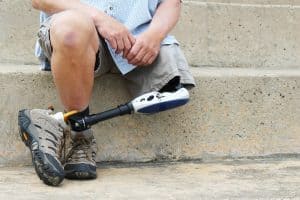Limb Amputation – Recovery and Complications
 The loss of a limb is an extremely traumatic injury, with a long recovery time, decreased functioning, a lifetime of complications, and emotional stress. When you suffer an accident that necessitates an amputation, your life may be altered forever in many ways.
The loss of a limb is an extremely traumatic injury, with a long recovery time, decreased functioning, a lifetime of complications, and emotional stress. When you suffer an accident that necessitates an amputation, your life may be altered forever in many ways.
However, you’re not alone. According to the National Limb Loss Information Center, nearly two million people are living with limb loss in the United States. Amputation injuries don’t just affect the person who suffered the limb loss either—their families are affected as well.
Causes of limb amputation
Limbs are typically amputated because of a traumatic injury or a medical condition. The most common type of limb loss is below the knee amputation. Frequent causes of amputations include:
- Trauma. About 45% of amputations occur as a result of trauma, according to the National Limb Loss Information Center. Often these traumas include motor vehicle accidents, where the limb is crushed or severed and cannot be saved.
- Infection. Severe infections can lead to dead tissue, making an amputation necessary to save the person’s life.
- Vascular disease. This is a disease involving a problem with the arteries, veins, or capillaries that carry blood from the heart to parts of the body. If this system doesn’t work properly, it causes a decreased blood flow to one or more limbs, necessitating amputation.
Recovery after limb loss
After a typical amputation procedure, the recovery process includes:
- Prosthetic. Many people opt to to use an artificial limb, as prosthetics have become more advanced over the past few decades. New materials have made artificial limbs more comfortable and lightweight, and some are designed specifically for sports for athletes. Fittings for prosthetics are dependent upon how the patient heals.
- Rehabilitation. Both physical and occupational therapy is necessary for amputation injuries. To compensate for limb loss, patients may need exercises to help them improve their strength to make up for their limb loss. Therapy also helps the patient learn to use adaptive devices for day-to-day living activities, or how to use their prosthesis.
Common amputation complications
The loss of a limb is a significant life adjustment. Unfortunately, in some instances, complications occur after the procedure or even much later, which can cause more physical and financial issues. Common complications after limb loss include:
- Infection. After an amputation procedure, the surgery site can become infected. Additionally, the stump can also experience blisters or skin degradation. Infections slow healing time and must be treated immediately.
- Phantom limb pain. Some people experience phantom limb pain after an amputation. This is feeling pain and discomfort from a part of the body that’s no longer there. Research suggests this pain happens because of sensations originating from the spinal cord.
- Muscle weakness. Because of reduced mobility during recovery, muscle weakness may occur. After limb loss, patients may need to carry more weight or perform more daily functions than before, and that additional work can lead to muscle fatigue, stiffness, and pain.
The road to recovery after a limb loss can be arduous and expensive. The costs of prosthetics, rehabilitation, and therapy are high and, if your accident was not your fault, you shouldn’t have to pay these bills. The loss of limb attorneys at Taylor Ring can help you seek compensation. We’ll fight tenaciously for justice. Talk to our Los Angeles lawyers today at 310.776.6390 or complete our contact form to schedule a consultation.
.

David Ring is a nationally renowned plaintiff’s personal injury trial attorney and has obtained multi-million dollar verdicts and settlements on behalf of seriously-injured individuals or families who have lost a loved one in a tragic accident. For more than 20 years, he has represented victims of sexual abuse, sexual harassment, assault, molestation and sexual misconduct in cases against a variety of employers and entities, including schools, churches and youth organizations.
He prides himself on providing aggressive, yet compassionate representation for children who have been sexually abused and women who have been sexually harassed or assaulted. Read more about David M. Ring.

